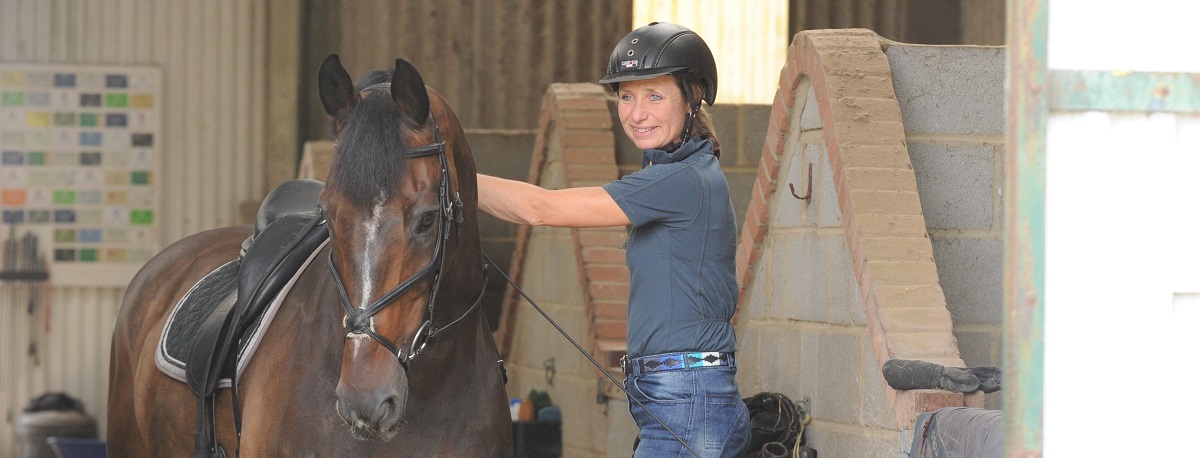
In the second instalment of "Vital Signs" we asked Caroline Mosley, a lecturer in Veterinary Clinical Skills at Edinburgh University to guide us through taking a horse's temperature, ensuring they're hydrated and getting to know the gut. Read on for advice on getting to know what is normal for your horse. If you missed the first blog on checking your horse's heart rate, you can read it here.
Respiratory rate
Taking a respiratory rate is usually easier if observed over one minute as the horses can take one breath every eight seconds! It can also be difficult to see the horse breathing unless they are out of breath or have been working. The chest is unlikely to rise and fall on a resting horse as the diaphragm does the work so the best place to see breathing is to look just beyond the rib cage and see the belly moving in and out.
A normal respiratory rate for a horse is around 8 - 12 breaths per minute (higher in foals).
Temperature
You can only obtain a temperature in a horse by popping a thermometer into the rectum. You will need a digital thermometer and be sure to apply a small amount of Vaseline to the tip before going ahead. You should make sure you are standing in a safe position to the side of the horse and lift the tail so you can see the anus. Gently slide the thermometer into the anus keeping the digital screen on the outside of the horse’s body and do not let go of it! (Yes, there have been cases of lost thermometers in a horse’s bottoms!)
Press the thermometer on and wait until it beeps.
The normal temperature of a horse is 37.5 – 38.5 centigrade. Knowing the regular temperature of your horse will help you assess your horse before you go to competitions or afterwards if you have to keep them in isolation or are generally concerned they may have picked up an infection.
Capillary refill time and mucous membranes assessment
This should be normal most of the time, it is not an assessment I do regularly on my horse, but it is an area I will assess if I am concerned my horse looks unwell.
A normal capillary refill time (CRT) should be less than two seconds, this is the time it takes for the blood to refill the capillaries after you have removed it. The way to remove it is to press on the gum for a second then release and watch the colour return to the area. If you wanted to practice first, place your hand flat on a table, then press on the palm of your hand at the base of your index finger then release and watch the colour return. This is what you do on the horse’s gum.
While doing the CRT you can also assess the colour of the mucous membranes (MM), this is the lining of the gum, eyelids nostrils, inside the anus etc. The gum is the easiest place to check and in a healthy horse should be a pink colour (slightly paler than a humans). If your horse has white, yellow, greyish blue then you should call your vet to discuss as this could be a sign of something serious.
Hydration
Horses should drink a good amount of water a day, more if in hard work (20 litres or more) so if concerned about their hydration then a quick assessment could be to carry out by doing a pinch test. Pinch the skin on the neck and let go, if it returns to normal within a second then your horse is hydrated. The longer this takes to return the more dehydrated the horse is. If you’re concerned call your vet and ask them to come and assess your horse.

Gut sounds
While not a vital sign, the gut sounds of a horse are an essential thing to be able to listen to. You should always be able to hear gut sounds in a horse and any cessation of them means there is a problem.
As the gut of a horse is constantly moving, breaking down food and propelling it along the tract you can hear a multitude of different sounds when listening with a stethoscope.
There are four areas to place your stethoscope – upper and lower quadrants on both sides. Be sure to listen to each area for at least 90 seconds and become familiar with your horse’s gut sounds as there are some noises that happen that are not part of the gut. Being aware of what normal sounds like you will then be able to tell when the sounds being hyper mobile (too fast) or hypo mobile (slow or stopped)
Do be careful when using a stethoscope on the gut, some horses find this tickly and can kick. If you are trying to listen to gut sounds on a horse that may be colicing please also be very careful not to get trapped against a wall. A colicing horse doesn’t think about keeping out of your way and you may end up injured even with the kindest horse in the world.
I hope this is helpful to you, my advice would be to go and have a practice and get to know what is normal for your horse.
If you are concerned about any of their vital signs, please call your vet. If you find it tricky to carry them out then ask your vet at their next visit to show you, they will be happy to help you as it will help them if you can take these readings.
Happy riding, Caroline xx
Caz Mosley BSc, RVN, C&GCertVNES, DipMgmt (Open), BHS CCH, PgCAP, SFHEA

